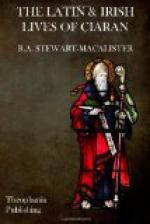INTRODUCTION
Of all the saints of Ireland, whose names are recorded in the native Martyrologies, probably there were none who made so deep an impression upon the minds of their fellow-countrymen as did Ciaran[1] of Clonmacnois. He stands, perhaps, second only to Brigit of Kildare in this respect; for Patrick was a foreigner, and Colum Cille accomplished his work and exercised his influence outside the shores of Ireland.
Doubtless much of the importance of Ciaran is reflected back from the outstanding importance of his great foundation—the monastic university, as it is fair to call it, of Cluain maccu Nois (in an English setting spelt “Clonmacnois"), on the shore of the Shannon. But this cannot be the whole explanation of the esteem in which he was held; it must be at least partly due to the memory of his own character and personality.
Such a conclusion is indicated if we examine critically the Lives of this saint, translations of which are given in the present volume, and compare them with the lives of other Irish saints. In studying all these documents we must bear in mind that none of them are, in any modern sense of the word, biographies. A biography, in the proper definition of the term, gives an ordered account of the life of its subject, with dates, and endeavours to trace the influences which shaped his character and his career, and the manner in which he himself influenced his surroundings. The so-called lives of saints are properly to be regarded as homilies. They were composed to be read to assemblies of the Faithful, as sermons for the festivals of the saints with whom they deal; and their purpose was to edify the hearers by presenting catalogues of the virtues of their subjects, and, especially, of their thaumaturgic powers. Thus they do not possess the unity of ordered and well-designed biographies; they consist of disconnected anecdotes, describing how this event or that gave occasion for a miraculous display.
It follows that to the historian in search of unvarnished records of actual fact these documents are useless, without most drastic criticism. They were compiled long after the time of their subjects, from tales, doubtless at first, and probably for a considerable time, transmitted by oral tradition. It would be natural that there should be much cross-borrowing, tales told about one saint being adapted to others as well, until they became stock incidents. It would also be nothing more than natural that many elements in the Lives should be survivals from more ancient mythologies, having their roots in pre-Christian beliefs. Nevertheless, none of these writings are devoid of value as pictures of life and manners; and even in descriptions of incredible and pointless miracles precious scraps of folk-lore are often embedded. In most, if not in all, cases, the incidents recorded in the Lives are to be criticised as genuine traditions, whatever their literal historicity may be; few, if any, are conscious inventions or impostures.[2]




